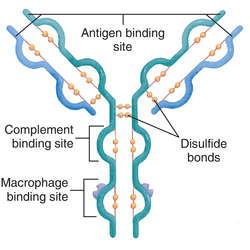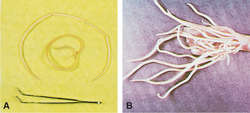antibody
(ant'i-bod?e) [ anti- + body], Ab


ANTIBODY: Structure of one igG molecule
A substance produced by B lymphocytes in response to a unique antigen. Each Ab molecule combines with a specific antigen to destroy or control it. All antibodies, except natural antibodies (antibodies to different blood types), are made by B cells stimulated by a foreign antigen, typically a foreign protein, polysaccharide, or nucleic acid. Synonym: immunoglobulin See:
illustration; antigen; autoantibody; cytokine; isoantibody
Antibodies neutralize or destroy antigens in several ways. They can initiate lysis of the antigen by activating the complement system; neutralize toxins released by bacteria, coating (opsonizing) the antigen or forming a complex to stimulate phagocytosis; promote antigen clumping (agglutination); or prevent the antigen from adhering to host cells.
An antibody molecule consists of four polypeptide chains (two light and two heavy), which are joined by disulfide bonds. The heavy chains form the complement-binding site, and the light and heavy chains form the site that binds the antigen.


ASCARIS LUMBRICOIDES
acetylcholine receptor binding antibody
Abbreviation: AChR-Ab
An autoantibody against acetylcholine receptors in the neuromuscular junction. Binding, blocking, or modulating antibodies against this receptor are found in the blood of most patients with generalized myasthenia gravis and in about half of all patients with ocular forms of the disease.
illustrationagonistic antibody
An antibody that stimulates or activates an organ. E.g., agonistic antibodies against the thyrotropin receptor in Grave disease stimulate the thyroid gland to release thyroid hormones that produce hyperthyroidism.
anticardiolipin antibody
Abbreviation: aCLa
An autoantibody against the cell membrane lipid, diphosphatidyl glycerol. It produces abnormal and sometimes life-threatening blood clotting. The antibody is found in a variety of autoimmune and infectious diseases, including in patients with the antiphospholipid antibody syndrome and syphilis.
anticyclic citrullinated peptide antibody
Abbreviation: anti-CCP
An antibody found in the serum of patients with rheumatoid arthritis but not in those with other joint or soft tissue diseases.
anti–DNase B antibody
An antibody formed during infection with group A beta-hemolytic streptococci. It is used, retrospectively, to help diagnose recent streptococcal infections.
antiendomysial antibody
An antibody that cross-reacts with smooth muscle collagen and the gluten in wheat, found in the serum of people with celiac sprue and some related autoimmune diseases.
antiendothelial cell antibody
An autoantibody present in the serum of patients with a variety of autoimmune diseases, including scleroderma (systemic sclerosis), systemic lupus erythematosus, interstitial lung diseases, and sarcoidosis. They attach to antigens on the cells that line blood vessels and injure those cells, producing blood vessel injury and inflammation (vasculitis).
antifibrillarin antibody
An autoantibody to the nucleolar protein fibrillarin, found in patients with diffuse systemic sclerosis (scleroderma), esp. those with relatively severe disease. It is identified more often in men than in women with the disease and in people of African descent as opposed to Europeans or Asians.
antiganglioside antibody
An antibody formed against the chemical components of nerves, found in the serum of those with Guillain-Barré syndrome.
antigliadin antibody
An antibody formed against the gluten in wheat, found in the serum of people with celiac sprue.
antileukocyte antibody
Any antibody found in plasma that, when donated and infused into a recipient, damages the recipient's white blood cells. Leukocyte injury after plasma exchange or infusion is the event that triggers transfusion-related acute lung injury.
anti-Hu antibody
An autoantibody associated with paraneoplastic encephalomyelitis. It is also known as ANNA-1 (antineuronal nuclear antibody-1).
antimicrosomal antibody
An autoantibody found in the plasma of patients with thyroid injury, e.g., in several forms of thyroiditis and other rheumatologic or autoimmune diseases.
anti-myeloperoxidase antibody
An antibody found in patients with several autoimmune vasculitides, such as microscopic polyangitis.
Synonym: perinuclear anti–neutrophil cytoplasmic antibodyantineuronal nuclear antibody
Abbreviation: ANNA
Any of several antibodies that bind to neuronal targets in the cerebrum and cerebellum, producing paraneoplastic neurological dysfunction. The antibodies are typically released by cancers such as small-cell carcinoma of the lung (also known as ANNA-1 and ANNA-2), testicular cancer (anti-Ta antibody), or breast cancer (ANNA-2).
antineutrophil cytoplasmic antibody
Abbreviation: ANCA
An autoantibody found in the blood of patients with certain forms of vasculitis (such as Churg-Strauss syndrome, microscopic polyangiitis, Wegener granulomatosis) esp. when it affects small blood vessels.
antinuclear antibody
Abbreviation: ANA
Any of a group of autoantibodies that react against normal components of the cell nucleus. These antibodies are present in a variety of immunologic diseases, including systemic lupus erythematosus, progressive systemic sclerosis, Sjögren syndrome, scleroderma, polymyositis, and dermatomyositis, and in some patients taking hydralazine, procainamide, or isoniazid. In addition, ANA is present in some normal people. Tests for ANAs are used in the diagnosis and management of autoimmune diseases.
antiphospholipid antibody
Abbreviation: aPLa
Any of a group of immunoglobulin autoantibodies that react with phospholipids, which are one of the primary components of the cell membrane (the other components are glycolipids and steroids). These antibodies are found in patients with a variety of connective tissue and infectious disorders, including systemic lupus erythematosus, the antiphospholipid antibody syndrome, syphilis, and malaria. They cause abnormal blood clotting, thrombocytopenia; and in women of childbearing age, repeated miscarriages. The anticardiolipin antibodies are one type of antiphospholipid antibody.
anti–proliferating cell nuclear antigen (PCNA) antibody
Abbreviation: anti-PCNA
An antibody found in the blood of patients with diseases in which cells replicate rapidly. Such conditions include autoimmune and inflammatory diseases and malignancies.
antiproteinase-3 antibody
An autoantibody found in patients with small blood vessel vasculitides, such as Wegener granulomatosis.
Synonym: diffusely cytoplasmic anti–neutrophil antibodyantireceptor antibody
An antibody that reacts with the antigen receptor on a cell rather than with an antigen itself.
antiribosomal P antibody
An autoantibody found in patients with systemic lupus erythematosus, esp. those with neurological or psychiatric manifestations of the disorder.
anti-scl-70 antibody
Anti-topoisomerase I antibody.antithyroperoxidase antibody
Abbreviation: TPOAb
A serum marker of autoimmune thyroid destruction, i.e., of Grave disease or Hashimotothyroiditis.
antititin antibody
An antibody that reacts with striated muscle cells. It is found principally in people with myasthenia gravis who also have thymoma.
anti-topoisomerase I antibody
An autoantibody found in the serum of patients with progressive systemic sclerosis, silicosis, and systemic lupus erythematosus. Higher levels of the antibody correlate with worsening kidney, lung, and skin disease.
Synonym: anti-scl-70 antibodyblocking antibody
An antibody that prevents an antigen from binding with a cellular receptor.
catalytic antibody
Abzyme.cross-reacting antibody
An antibody that reacts with antigens other than its specific antigen because they contain binding sites that are structurally similar to its specific antigen.
See: antigenic determinantcytotoxic antibody
An antibody that lyses cells by binding to a cellular antigen and activating complement or killer cells.
diffusely cytoplasmic anti-neutrophil cytoplasmic antibody
Abbreviation: C-ANCA.
Antiproteinase-3 antibody.direct fluorescein-conjugated antibody
Abbreviation: DFA
Direct fluorescent antibody.direct fluorescent antibody
Abbreviation: DFA
A fluorescent antibody test performed on sputum to detect microorganisms that invade the respiratory tract, e.g., Legionella, Mycoplasma, or Bacillus anthracis.
Synonym: direct fluorescein-conjugated antibody; direct immunofluorescence testDonath-Landsteiner antibody
See: Donath-Landsteiner antibodyfluorescent antibody
Abbreviation: FA
An antibody that has been stained or marked by a fluorescent material. The fluorescent antibody technique permits rapid diagnosis of various infections.
glutamic acid decarboxylase antibody
Abbreviation: GADA
An antibody to glutamic acid decarboxylase. It is a serum marker of type 1 diabetes mellitus and is found in the blood of patients with stiff-person syndrome.
immune antibody
An antibody produced by immunization or as a result of transfusion of incompatible blood.
maternal antibody
An antibody produced by the mother and transferred to the fetus in utero or during breastfeeding.
monoclonal antibody
Abbreviation: MoAB
A type of antibody, specific to a certain antigen, created in the laboratory from hybridoma cells. Because monoclonal antibodies are derived from a single cell line and raised against a single antigen, they are highly specific. Diagnostically, they are used to identify microorganisms, white blood cells, hormones, and tumor antigens. In patient care, they are used to treat transplant rejection, certain cancers, and autoimmune diseases.
Hybridoma cells, used to produce monoclonal antibodies, are formed by the fusion of a spleen cell from a mouse immunized with an antigen and a multiple myeloma cell (a cancerous plasma B cell). The fused cells are screened to identify those that secrete antibodies against a specific antigen. A continuous supply of these antigen-specific monoclonal antibody secreting cells can then be grown in cultures.
See:
antibody; B cell; hybridoma
natural antibody
An antibody present in a person without known exposure to the specific antigen, such as an anti-A antibody in a person with B blood type.
panel reactive antibody
Abbreviation: PRA
A measure of an organ transplant recipient's level of sensitization to antigens on donated organs. It is the percentage of cells taken from a broad selection of blood donors against whose antigens the organ recipient's serum reacts. The higher the panel reactive antibody, the more challenging it is to match a donor organ to the recipient.
perinuclear antineutrophil cytoplasmic antibody
Antimyeloperoxidase antibody.p504s antibody
Alpha-methylacyl-CoA racemase.polyclonal antibody
An antibody that reacts with many different antigens.
protective antibody
An antibody produced in response to an infectious disease. See: immunity
radionuclide-linked monoclonal antibody
A monoclonal antibody to which a radioisotope has been attached. The antibody attaches to receptors on the surface of undesired cells (e.g., cancer cells) and delivers a dose of radiation directly to those cells, leaving healthy cells and tissues relatively unaffected.
sensitizing antibody
Reagin.toxin-linked monoclonal antibody
A monoclonal antibody to which a cell-killing drug has been attached. The antibody combines preferentially with receptors on undesired cells (such as cancer cells) and delivers its lethal drug to those cells but not to healthy cells and tissues. To increase their effectiveness and decrease immune responses to these cells, genes for antigen binding sites from human antibodies are added, creating humanized monoclonal antibodies.
warm antibody
Warm autoagglutinin.illustration
antineutrophil cytoplasmic antibody
Abbreviation: ANCA
An autoantibody found in the blood of patients with certain forms of vasculitis (such as Churg-Strauss syndrome, microscopic polyangiitis, Wegener granulomatosis) esp. when it affects small blood vessels.
See also: antibody
Medical Dictionary, © 2009 Farlex and Partners

